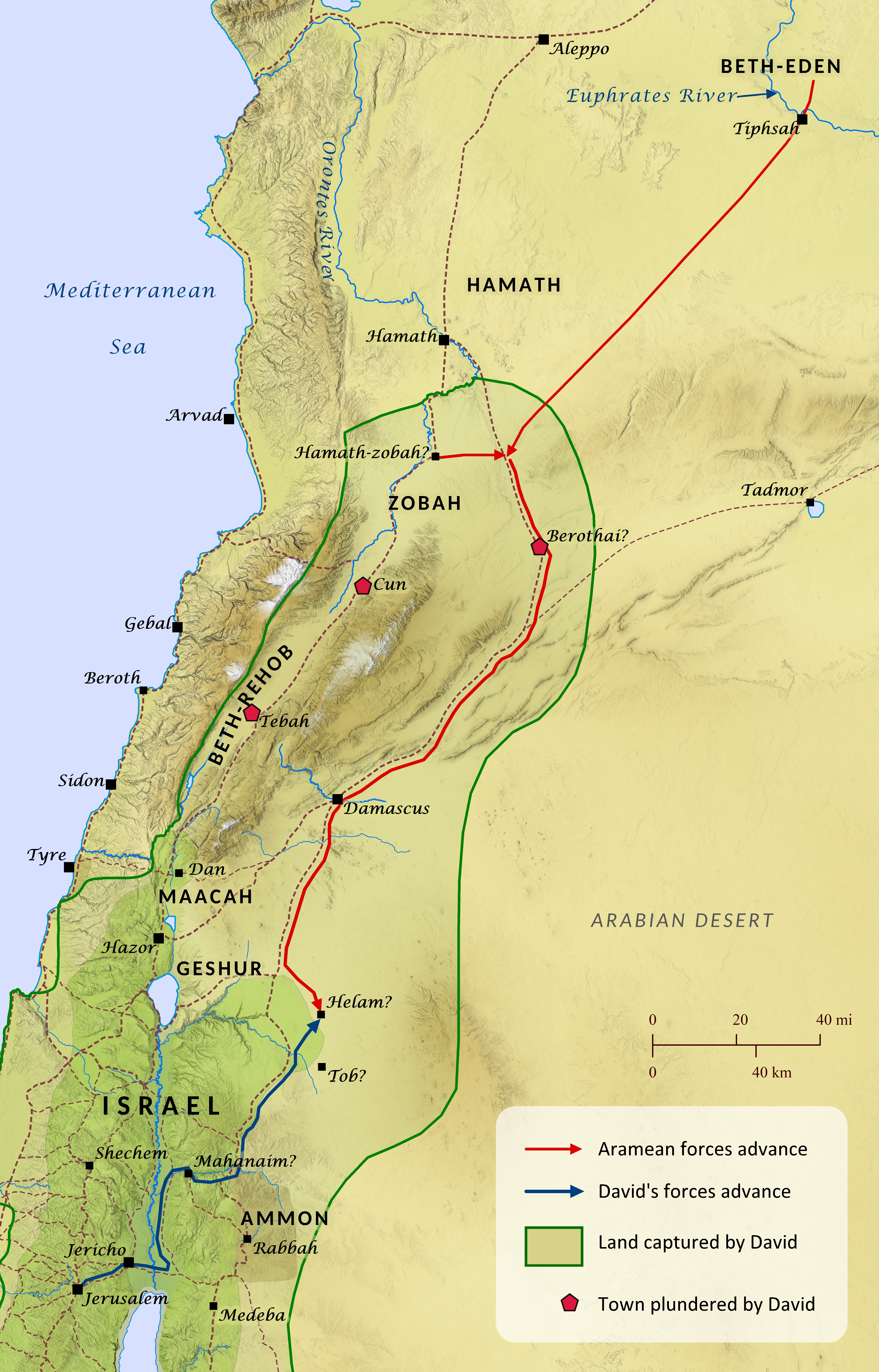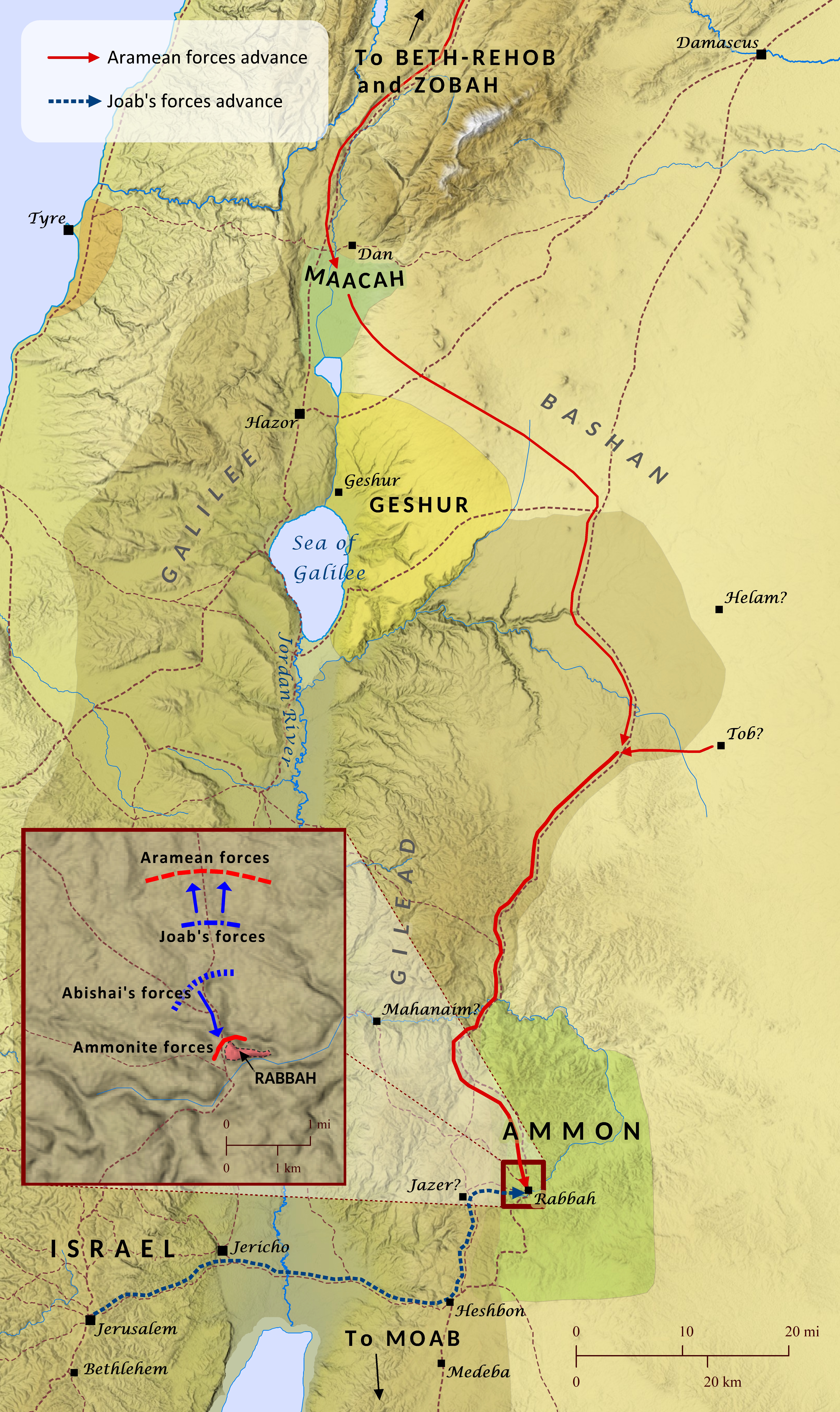
David Defeats the Ammonites and the Arameans
2 Samuel 8:1-8; 10:1-19; 12:21-31; 1 Chronicles 18:2-11; 19:1-19; 20:1-3
The accounts of David’s greatest military victories stand like bookends around the record of David’s most grievous sins. Sometime after David brought the Ark of the Covenant into Jerusalem and the Lord promised to establish his dynasty over Israel, David achieved a series of victories over virtually all of Israel’s neighboring nations. These began with David’s capture of Metheg-ammah (likely Gath) and all of Philistia and was followed by his victory over Moab. Then Nahash king of Ammon died, and David sent envoys to express his condolences to Nahash’s son Hanun, who had now become king. Hanun, however, intentionally humiliated David’s envoys, shaving off half their beards and cutting off the bottom half of their garments before sending them back to Israel. When David heard of it, he sent word to his envoys to remain at Jericho until their beards grew back. In the meantime, the Ammonites called upon several Aramean nations to help them fight against Israel, which was likely their original intent for humiliating David’s envoys. Warriors came from Beth-rehob and Zobah, which lay between Israel and Hamath farther north, as well as from Maacah (see “Geshur and Maacah” map) and Tob. The writer of 1 Chronicles also notes that soldiers came from Mesopotamia as well. David sent his commander Joab to fight this coalition at Rabbah. The writer of 1 Chronicles consistently speaks of the battle occurring at Medeba, rather than Rabbah, but the town of Medeba south of Heshbon seems an unlikely location for the battle. Perhaps Rabbah was also referred to at times as Medeba. In any case, Joab and his brother Abishai divided their forces into two groups, with Joab leading the fight against the Arameans to the north and Abishai leading the fight against the Ammonites just outside the gates of Rabbah. As Joab advanced, the Arameans fled, which in turn led the Ammonites to retreat behind the walls of Rabbah. After this Joab (and probably his forces) returned home to Israel. But the Arameans regrouped and added more troops from Aramean nations beyond the Euphrates River. David met them in battle at Helam (likely modern Alma) and won a great victory over them, even killing their commander Shobah (or Shophach). After this the Arameans made peace with Israel. Sometime later David also subjugated the Edomites, who lived to the south of Moab. It was likely sometime after this that David engaged in adultery with the wife of Uriah, one of his own valiant warriors (see “David’s Mighty Men” map), and then he tried to cover up his sin by arranging for Uriah’s death in battle. His sin was later exposed by Nathan the prophet, and David repented. After this Joab returned to Rabbah to finish capturing the city, and when victory was close at hand he called for David to come and finish taking the city. Thus the Ammonites became subject to Israel as well. From all these conquered nations David took many spoils and dedicated them to the Lord’s service, including great amounts of bronze from the towns of Tebah (also called Betah and Tibhath), Berothai, and Cun.
The Battle with the Ammonites and the Arameans
The Battle with the Arameans

David Defeats the Ammonites and the Arameans
2 Samuel 8:1-8; 10:1-19; 12:21-31; 1 Chronicles 18:2-11; 19:1-19; 20:1-3
The accounts of David’s greatest military victories stand like bookends around the record of David’s most grievous sins. Sometime after David brought the Ark of the Covenant into Jerusalem and the Lord promised to establish his dynasty over Israel, David achieved a series of victories over virtually all of Israel’s neighboring nations. These began with David’s capture of Metheg-ammah (likely Gath) and all of Philistia and was followed by his victory over Moab. Then Nahash king of Ammon died, and David sent envoys to express his condolences to Nahash’s son Hanun, who had now become king. Hanun, however, intentionally humiliated David’s envoys, shaving off half their beards and cutting off the bottom half of their garments before sending them back to Israel. When David heard of it, he sent word to his envoys to remain at Jericho until their beards grew back. In the meantime, the Ammonites called upon several Aramean nations to help them fight against Israel, which was likely their original intent for humiliating David’s envoys. Warriors came from Beth-rehob and Zobah, which lay between Israel and Hamath farther north, as well as from Maacah (see “Geshur and Maacah” map) and Tob. The writer of 1 Chronicles also notes that soldiers came from Mesopotamia as well. David sent his commander Joab to fight this coalition at Rabbah. The writer of 1 Chronicles consistently speaks of the battle occurring at Medeba, rather than Rabbah, but the town of Medeba south of Heshbon seems an unlikely location for the battle. Perhaps Rabbah was also referred to at times as Medeba. In any case, Joab and his brother Abishai divided their forces into two groups, with Joab leading the fight against the Arameans to the north and Abishai leading the fight against the Ammonites just outside the gates of Rabbah. As Joab advanced, the Arameans fled, which in turn led the Ammonites to retreat behind the walls of Rabbah. After this Joab (and probably his forces) returned home to Israel. But the Arameans regrouped and added more troops from Aramean nations beyond the Euphrates River. David met them in battle at Helam (likely modern Alma) and won a great victory over them, even killing their commander Shobah (or Shophach). After this the Arameans made peace with Israel. Sometime later David also subjugated the Edomites, who lived to the south of Moab. It was likely sometime after this that David engaged in adultery with the wife of Uriah, one of his own valiant warriors (see “David’s Mighty Men” map), and then he tried to cover up his sin by arranging for Uriah’s death in battle. His sin was later exposed by Nathan the prophet, and David repented. After this Joab returned to Rabbah to finish capturing the city, and when victory was close at hand he called for David to come and finish taking the city. Thus the Ammonites became subject to Israel as well. From all these conquered nations David took many spoils and dedicated them to the Lord’s service, including great amounts of bronze from the towns of Tebah (also called Betah and Tibhath), Berothai, and Cun.
The Battle with the Ammonites and the Arameans
The Battle with the Arameans